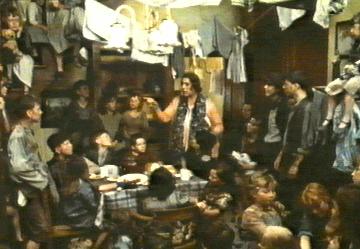As I have documented in my 'real' blog this month, Livie has made some tremendous progress just before she began the tDCS therapy sessions. In mid December, she began taking herself to the bathroom on her own. This is after almost a year of working with her on a schedule. She had suddenly decided to go into the bathroom on her own. I speculate that some of this had to do with the fact that about a month earlier, she had finally learned how to open a doornob; that freedom to come and go from the bathroom may have given her the confidence to recognize and act on her 'urges' independently. In any event it was a momentous breakthrough.
Also, a couple of weeks before this, Liv had began to use a verbal request for a particular food item from me. Paa..Paa, she would say after she had pointed my hand to the new Potato Snacks she loves. Also two of her therapist had commented that she had been more verbal of late
Thursday, December 25, 2008
Pre-Treatmnet Skill Sets
Livie's signs:
More
Cookie
Gum
Juice
Waves Goodbye
Pretzel
Chip
Apple- S
Candy
Jump
Ball
Music
Tickle
Puzzle- S
Book
Movie
Block- S
Hug
Squeeze
Scratch
Bead- S
Peg-S
Bathroom
Livie's vocalizations (prompted)
Cookie- Cuuk; cuukee
Pretzel- Paa
Potato Stick- Paa
Daddy- DaDa; Da
Mommy- Mama; ma
Ball- ba
Goodbye- bu; bu-bi
Chip- cha
Candy- K-ndee
Cup- k-up
Not prompted:
No- nah; nanah
Juice- Ja
More
Cookie
Gum
Juice
Waves Goodbye
Pretzel
Chip
Apple- S
Candy
Jump
Ball
Music
Tickle
Puzzle- S
Book
Movie
Block- S
Hug
Squeeze
Scratch
Bead- S
Peg-S
Bathroom
Livie's vocalizations (prompted)
Cookie- Cuuk; cuukee
Pretzel- Paa
Potato Stick- Paa
Daddy- DaDa; Da
Mommy- Mama; ma
Ball- ba
Goodbye- bu; bu-bi
Chip- cha
Candy- K-ndee
Cup- k-up
Not prompted:
No- nah; nanah
Juice- Ja
A Little Background...
Livie is currently 6 years+ with what I would characterize as severe autism. Her main issue is her lack of communication, specifically verbal communication. She had some 50 odd words when she was 15 months old and slowly regressed over 6 months to no words. She has been diagnosed as having apraxia of speech and has ha trouble using her mouth and tongue muscles to form words.
Today, or should I say just before we started this therapy, she had about 6-8 sounds that are word approximations; she has between 18-24 signs for objects/needs and will pull us by the hand and 'throw' our hand and the object of her desire.
We enrolled her in a study at Columbia in NYC to study the brain functions of non verbal autistic children using a Functional MRI. This data should show specifically where the deficits in communication are in the pathways of the brain (need to get specific names of receptive communicative and emotive pathways). She had her fMRI in Nov 08
In addition to this study, we are also going through a doctor who specializes in language therapy to use transcranial Direct Current Stimulation to target the specific areas of the pathways where they might be deficits. This method uses the tDCS in concert with language therapy, specifically passive language therapy, which could probably be construed as a combination play therapy and a sort of Verbal Behavior ABA for language. The technique calls for therapists and us to play with her while she is using the tDCS and try and get verbal interaction to words and phrases given to her in rapid and ever-changing combinations. The idea is to expose her to various ways of saying things and to encourage her to respond without her thinking or feeling that she is in a 'teaching' environment.
I'm going to try and keep a diary of hopefully daily, at least weekly progress reports; changes, additions, behavioral improvements and setbacks. basically a chronical of what we notice and how she progresses.
Today, or should I say just before we started this therapy, she had about 6-8 sounds that are word approximations; she has between 18-24 signs for objects/needs and will pull us by the hand and 'throw' our hand and the object of her desire.
We enrolled her in a study at Columbia in NYC to study the brain functions of non verbal autistic children using a Functional MRI. This data should show specifically where the deficits in communication are in the pathways of the brain (need to get specific names of receptive communicative and emotive pathways). She had her fMRI in Nov 08
In addition to this study, we are also going through a doctor who specializes in language therapy to use transcranial Direct Current Stimulation to target the specific areas of the pathways where they might be deficits. This method uses the tDCS in concert with language therapy, specifically passive language therapy, which could probably be construed as a combination play therapy and a sort of Verbal Behavior ABA for language. The technique calls for therapists and us to play with her while she is using the tDCS and try and get verbal interaction to words and phrases given to her in rapid and ever-changing combinations. The idea is to expose her to various ways of saying things and to encourage her to respond without her thinking or feeling that she is in a 'teaching' environment.
I'm going to try and keep a diary of hopefully daily, at least weekly progress reports; changes, additions, behavioral improvements and setbacks. basically a chronical of what we notice and how she progresses.
Subscribe to:
Comments (Atom)
